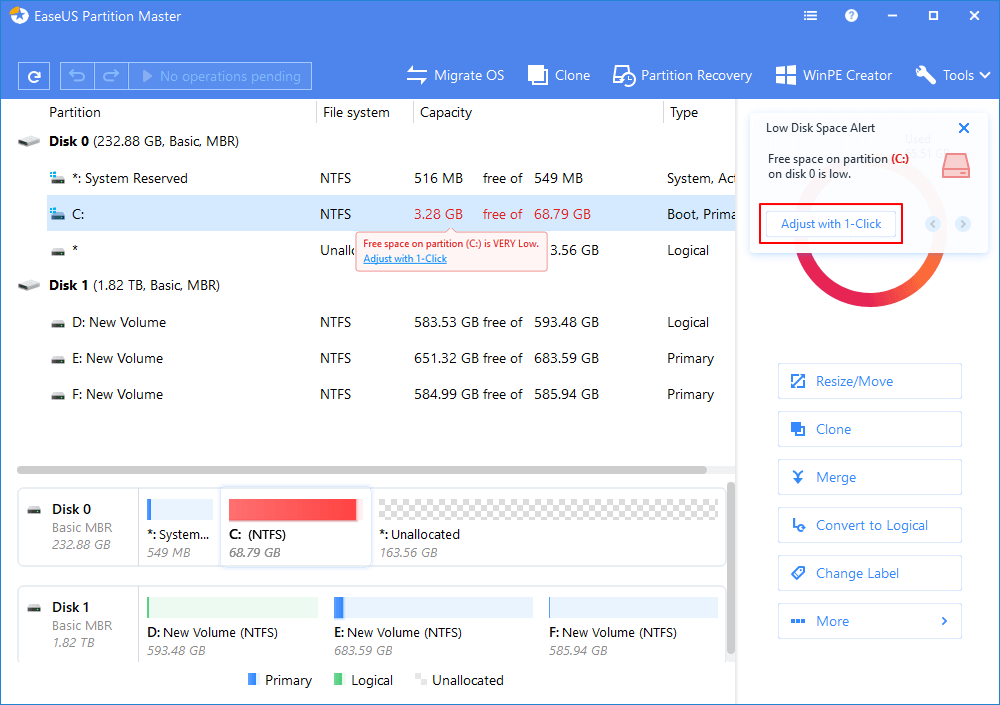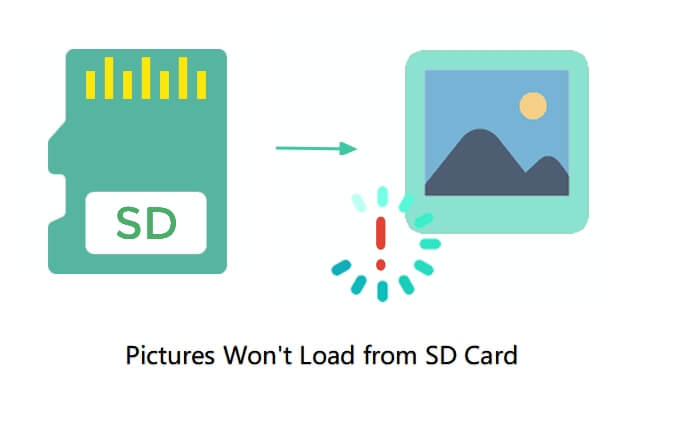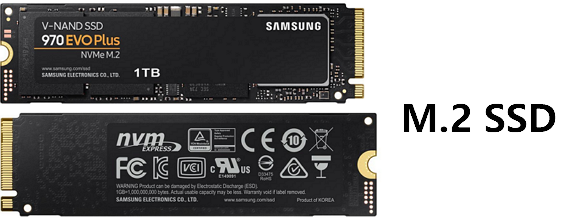-
![]()
-
![]() [Error 5] Unable To Execute Files In The Temporary Directory | How to Fix
[Error 5] Unable To Execute Files In The Temporary Directory | How to Fix January 13,2026
January 13,2026 6 min read
6 min read -
![]() How to Fix External Hard Drive Takes Long Time to Open and Read
How to Fix External Hard Drive Takes Long Time to Open and Read January 13,2026
January 13,2026 6 min read
6 min read -
![]() How to Fix 0x800703EE Error Code in Windows Efficiently
How to Fix 0x800703EE Error Code in Windows Efficiently January 13,2026
January 13,2026 6 min read
6 min read -
![]() Fix Failed to Load Photo in SD card Error (7+ Ways)
Fix Failed to Load Photo in SD card Error (7+ Ways) January 13,2026
January 13,2026 6 min read
6 min read -
![]()
-
![]() How to Fix Inaccessible Boot Device Windows 11 | 8 Best Solutions Here
How to Fix Inaccessible Boot Device Windows 11 | 8 Best Solutions Here January 13,2026
January 13,2026 6 min read
6 min read -
![]() Genshin Impact Size on Laptop/PS4/Mobile [All You Need to Know]
Genshin Impact Size on Laptop/PS4/Mobile [All You Need to Know] January 13,2026
January 13,2026 6 min read
6 min read -
![]() Fix Unable to Activate Windows After Hardware Change
Fix Unable to Activate Windows After Hardware Change January 13,2026
January 13,2026 6 min read
6 min read -
![]()
To recover deleted files after reinstalling Windows 11, you can apply professional Windows data recovery software, File History, or System Restore. A reliable Windows recovery tool like EaseUS Data Recovery Wizard can help you deeply scan your disk and find remaining data.
PAGE CONTENT:
Recover Deleted Files After Reinstalling Windows Is Possible
"Please help me! I have reinstalled Windows and lost everything on my computer! I have lost windows.old too when trying to fix it."
It's possible to recover deleted files after reinstalling Windows 11/10/8/7 with various solutions.
There are many reasons for reinstalling a new Windows OS from scratch. For example, after reinstalling Windows 10, you can enjoy benefits like removing viruses/malware, regaining control over your programs, and fixing system-related issues on your computer. Besides, reinstalling Windows also provides you with a fresh start to speed up your computer. Apart from the known advantages, you will also need to reinstall Windows in some specific situations.
Reasons for Reinstalling Windows OS:
- Windows system files are deleted or corrupted
- The Windows registry has been corrupted
- Hardware failure causes a Windows system crash
- Fail to remove the virus/spyware
- A sudden blue or black screen of death (BSOD)
- Windows system upgrades or updates
- Other unknown reasons that cause the Windows system to be unbootable
Windows data and files may not be deleted permanently after reinstalling Windows 11/10/8/7. The lost files can still be recovered using reliable methods. In this passage, you will uncover three proven & practical ways to recover deleted files after reinstalling Windows 11/10/8/7 using Windows data recovery software, Windows File History Backup, and performing System Restore.
Fix 1. Recover Deleted Files After Reinstalling Windows 10 with Data Recovery Software
The first recommended method is to apply Windows recovery software - EaseUS Data Recovery Wizard. If you are not a data recovery expert, this tool is your best choice. It helps you recover lost data in a few clicks.
Here are the amazing features of EaseUS Data Recovery Wizard.
- Recover files after a factory reset. It supports deleted data recovery, formatted file recovery, lost partition recovery, OS crash recovery, RAW partition recovery, and more.
- Flexible Scanning Modes. It offers both the Quick Scan and Advanced Scan to help you find the needed data.
- Preview Before Recovery. To make sure the file contents are alright, the EaseUS recovery tool enables you to preview lost files before the actual recovery.
Download and apply this software immediately to perform data recovery after a Windows reinstall.
Note: To guarantee a high data recovery chance, install EaseUS data recovery software on another disk instead of the original disk where you lost files.
Step 1. Launch EaseUS Data Recovery Wizard on your Windows 11, Windows 10, Windows 8, or Windows 7 computer. Select the disk partition or storage location where you lost data and click "Search for Lost Data".

Step 2. This recovery software will start scanning the disk to find all lost and deleted files. When the scan process completes, click "Filter" > "Type" to specify lost file types. If you remember the file name, you can also search in the search box, which is the fastest way to find the target file.

Step 3. Preview and restore lost Windows files. You can double-click to preview the scanned files. Then, select the target data and click the "Recover" button to save them to another safe spot in the PC or Cloud drive.

EaseUS data recovery tool is reliable, and many Windows users have recovered lost data with it.
| 📒Review | The application is very good and it is helping me to recover my lost data. I bought this product some days ago and I think it is a good help and I had a good support too. Thank you very much. - from Trustpilot |
Don't forget to share this handy Windows data recovery to reinstall Windows without losing data.
Fix 2. Recover Data After Windows Installation with File History
If you have no backup available, using a data recovery tool is recommended. However, if you have backed up your lost files via Windows File History, you can recover the lost files from the backup location. Here are the detailed steps to help you find old files after reinstalling Windows:
Step 1. Open "Settings" and select "Update & Security".
Step 2. Find the "Backup" option to locate your backup.

Step 3. Under "Back up using File History", choose "More options".
Step 4. Scroll down to the "Related settings" section and choose "Restore files from a current backup".
Step 5. Look for the file you need, then use the arrows to see all its versions.
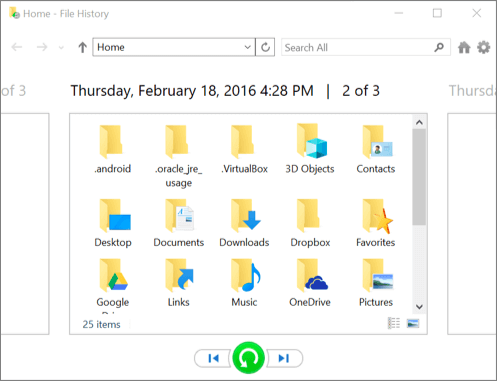
Step 6. When you find the version you want, select "Restore" to save it in its original location.
To save it in a different place, right-click "Restore" > "Restore to", and then choose a new location.
Fix 3. Recover Data After Reinstalling Windows with System Restore
Please note that if you create a system restore point on your computer, you can use it to recover files lost due to Windows reinstallation. However, this will revert your OS to the previous status.
If this is not the result you expected, try the former two methods. If you don't mind reinstalling Windows 11/10/8/7 on your computer again, you may follow the steps below and give it a try:
Step 1. Press the "Windows + R" keys in Windows 11/10/8/7 to bring up the Run box.
Step 2. Type rstrui.exe in the empty box and hit Enter. This will open System Restore.
Step 3. Select "Choose a different restore point" and click "Next".
Step 4. Click "Scan for affected programs".
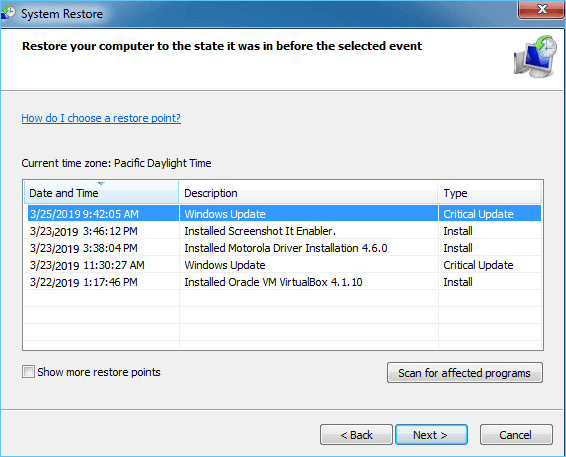
Step 5. If none of your data drives is affected, click "Next" to finish the process.
If your data drive is affected, back up your saved data to an external hard drive in advance. Then follow the onscreen instruction to finish the procedure. You can share all the three Windows reinstallation recovery methods on social media to help more users!
Windows Reset vs. Reinstall vs. Clean Install: Will it Keep My Files?
There are three types of reinstalls for Windows 10. In general, Microsoft recommends that you first try to "Reset Windows 10", then if needed, "Reinstall Windows 10 using installation media", and then if needed try a "Clean install of Windows 10 using installation media". Different options of the reinstall will have different impacts on your apps, files, personal data, and how likely it is to recover data after reinstalling Windows.
| Reinstall Type | Reinstall options you can choose | What happens to data, files and folders |
|---|---|---|
| Reset Windows 10 | Keep my files | Preserved |
| Reset Windows 10 | Remove everything | Deleted |
| Reinstall Windows 10 using installation media | Keep Everything (Default) | Preserved |
| Reinstall Windows 10 using installation media | Keep Personal Data | Preserved |
| Reinstall Windows 10 using installation media | Keep Nothing | Deleted |
| Clean install Windows 10 using installation media |
N/A (This option deletes and recreates all disk partitions) |
Preserved |
If you have personal data and files that you want to save, back them up to an external hard drive, USB thumb drive, SD card, or cloud location (such as OneDrive) before you begin to reinstall Windows 10. Otherwise, make sure that you choose the right reinstall options to preserve data or remove all during the reinstallation.
How to Reinstall or Clean Install Windows OS Without Data Loss
To ensure you can reinstall Windows 10, Windows 8, or earlier versions without data loss, here are some useful tips for you.
# 1. Back up Files in Advance
Windows reinstallation will inevitably cause data loss on your computer hard drive as demonstrated on this page. Therefore, it's important to back up your important files in advance.
- When you attempt to reinstall Windows on a working PC, you can use the disk cloning software to make a copy of your disk or partition, which is much faster than manually copying and pasting.
- If you try to reinstall Windows on a non-bootable PC, don't worry. You can use the Windows backup software to create bootable media and back up your files before the installation.
# 2. Migrate Windows Without Reinstalling OS
When you clean install Windows 10/8/7 on another, you will lose all your apps, settings, and files after the reinstallation. If you want to keep them, a better choice for you is to migrate OS.
The Bottom Line
This page answers the questions of how to recover lost files after reinstalling Windows 11/10/8/7 by using Windows data recovery software, File History, and System Restore. If you don't have a backup or system restore point, EaseUS Data Recovery Wizard is your last choice for bringing the lost files back.
Moreover, keep two things in mind to avoid complete data loss during Windows reinstall: make sure you have backed up the files you need before the installation and perform data recovery as soon as possible once there is unexpected data loss.
Recover Files After Windows Reinstallation FAQs
By reading through the article, you should be able to recover files after reinstalling Windows 11/10/8/7 by yourself. Meanwhile, we summarized the answers to the most concerning questions that you might also be interested in.
1. How do I reinstall old Windows and keep files?
There are two things that you should do to keep files on your computer while reinstalling Windows 10:
- First, create a backup of your files in advance. You may manually copy or use advanced Windows backup software to fully back up your data to an external hard drive in advance.
- Next, don't tick "Remove files and clean the drive", but tick "Keep all my files" instead while installing Windows.
2. Do you lose file when reinstalling Windows?
Basically, the answer to this question is yes. Windows reinstallation is the process of replacing everything on the old system drive with the new Windows files. During the process, files saved on the desktop, Documents, Music, Image, etc. folders, and in the C: drive will all be removed.
In a word, you will lose some files when reinstalling Windows even if you tick the "Keep all my files" option at the beginning installing process. To avoid this tragedy, back up all your valuable files to an external hard drive in advance. You may refer to Backup Computer to USB Flash Drive as a guide.
3. Is it possible to recover data after Windows 10 reset?
Basically, Windows 10 reset will offer users a chance to decide whether you want to keep the files on your computer or not. If you have set the computer to keep your files, most of your data saved data on the none system partition will be safely kept.
But the system C drive saved files will be removed during the process. Fortunately, you still have a chance to restore them as long as you haven't save new files on it.
The process is similar to the provided methods on this page: 1) Use EaseUS data recovery software to fully scan and restore all lost data. 2). Use File History Backup; 3) Perform System Restore.
Was this page helpful?
-
Dany is an editor of EaseUS who lives and works in Chengdu, China. She focuses on writing articles about data recovery on Mac devices and PCs. She is devoted to improving her writing skills and enriching her professional knowledge. Dany also enjoys reading detective novels in her spare time. …
-
Evan Galasso is a digital forensics and data recovery engineer with over 10 years of experience in the field. He presents opinions on the current state of storage media, reverse engineering of storage systems and firmware, and electro-mechanical systems of SSDs and HDDs.…

20+
Years of experience

160+
Countries and regions

72 Million+
Downloads

4.9 +
Trustpilot Score


Free Data
Recovery Software
Recover data up to 2GB for free!




